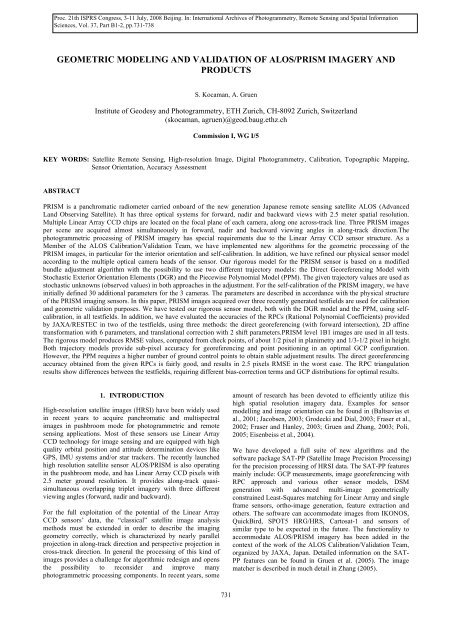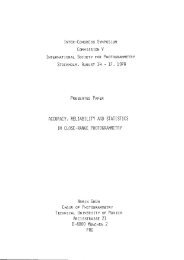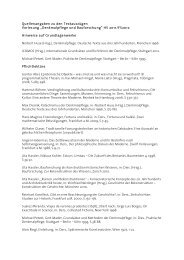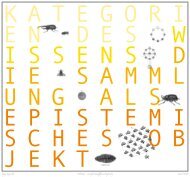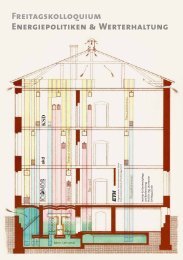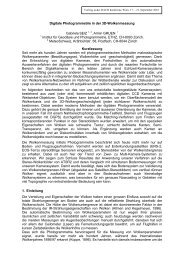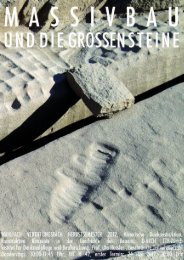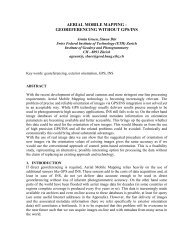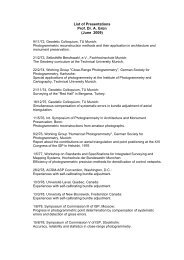Geometric modeling and validation of ALOS/PRISM imagery ... - IDB
Geometric modeling and validation of ALOS/PRISM imagery ... - IDB
Geometric modeling and validation of ALOS/PRISM imagery ... - IDB
You also want an ePaper? Increase the reach of your titles
YUMPU automatically turns print PDFs into web optimized ePapers that Google loves.
GEOMETRIC MODELING AND VALIDATION OF <strong>ALOS</strong>/<strong>PRISM</strong> IMAGERY AND<br />
PRODUCTS<br />
S. Kocaman, A. Gruen<br />
Institute <strong>of</strong> Geodesy <strong>and</strong> Photogrammetry, ETH Zurich, CH-8092 Zurich, Switzerl<strong>and</strong><br />
(skocaman, agruen)@geod.baug.ethz.ch<br />
Commission I, WG I/5<br />
KEY WORDS: Satellite Remote Sensing, High-resolution Image, Digital Photogrammetry, Calibration, Topographic Mapping,<br />
Sensor Orientation, Accuracy Assessment<br />
ABSTRACT<br />
<strong>PRISM</strong> is a panchromatic radiometer carried onboard <strong>of</strong> the new generation Japanese remote sensing satellite <strong>ALOS</strong> (Advanced<br />
L<strong>and</strong> Observing Satellite). It has three optical systems for forward, nadir <strong>and</strong> backward views with 2.5 meter spatial resolution.<br />
Multiple Linear Array CCD chips are located on the focal plane <strong>of</strong> each camera, along one across-track line. Three <strong>PRISM</strong> images<br />
per scene are acquired almost simultaneously in forward, nadir <strong>and</strong> backward viewing angles in along-track direction.The<br />
photogrammetric processing <strong>of</strong> <strong>PRISM</strong> <strong>imagery</strong> has special requirements due to the Linear Array CCD sensor structure. As a<br />
Member <strong>of</strong> the <strong>ALOS</strong> Calibration/Validation Team, we have implemented new algorithms for the geometric processing <strong>of</strong> the<br />
<strong>PRISM</strong> images, in particular for the interior orientation <strong>and</strong> self-calibration. In addition, we have refined our physical sensor model<br />
according to the multiple optical camera heads <strong>of</strong> the sensor. Our rigorous model for the <strong>PRISM</strong> sensor is based on a modified<br />
bundle adjustment algorithm with the possibility to use two different trajectory models: the Direct Georeferencing Model with<br />
Stochastic Exterior Orientation Elements (DGR) <strong>and</strong> the Piecewise Polynomial Model (PPM). The given trajectory values are used as<br />
stochastic unknowns (observed values) in both approaches in the adjustment. For the self-calibration <strong>of</strong> the <strong>PRISM</strong> <strong>imagery</strong>, we have<br />
initially defined 30 additional parameters for the 3 cameras. The parameters are described in accordance with the physical structure<br />
<strong>of</strong> the <strong>PRISM</strong> imaging sensors. In this paper, <strong>PRISM</strong> images acquired over three recently generated testfields are used for calibration<br />
<strong>and</strong> geometric <strong>validation</strong> purposes. We have tested our rigorous sensor model, both with the DGR model <strong>and</strong> the PPM, using selfcalibration,<br />
in all testfields. In addition, we have evaluated the accuracies <strong>of</strong> the RPCs (Rational Polynomial Coefficients) provided<br />
by JAXA/RESTEC in two <strong>of</strong> the testfields, using three methods: the direct georeferencing (with forward intersection), 2D affine<br />
transformation with 6 parameters, <strong>and</strong> translational correction with 2 shift parameters.<strong>PRISM</strong> level 1B1 images are used in all tests.<br />
The rigorous model produces RMSE values, computed from check points, <strong>of</strong> about 1/2 pixel in planimetry <strong>and</strong> 1/3-1/2 pixel in height.<br />
Both trajectory models provide sub-pixel accuracy for georeferencing <strong>and</strong> point positioning in an optimal GCP configuration.<br />
However, the PPM requires a higher number <strong>of</strong> ground control points to obtain stable adjustment results. The direct georeferencing<br />
accuracy obtained from the given RPCs is fairly good, <strong>and</strong> results in 2.5 pixels RMSE in the worst case. The RPC triangulation<br />
results show differences between the testfields, requiring different bias-correction terms <strong>and</strong> GCP distributions for optimal results.<br />
1. INTRODUCTION<br />
High-resolution satellite images (HRSI) have been widely used<br />
in recent years to acquire panchromatic <strong>and</strong> multispectral<br />
images in pushbroom mode for photogrammetric <strong>and</strong> remote<br />
sensing applications. Most <strong>of</strong> these sensors use Linear Array<br />
CCD technology for image sensing <strong>and</strong> are equipped with high<br />
quality orbital position <strong>and</strong> attitude determination devices like<br />
GPS, IMU systems <strong>and</strong>/or star trackers. The recently launched<br />
high resolution satellite sensor <strong>ALOS</strong>/<strong>PRISM</strong> is also operating<br />
in the pushbroom mode, <strong>and</strong> has Linear Array CCD pixels with<br />
2.5 meter ground resolution. It provides along-track quasisimultaneous<br />
overlapping triplet <strong>imagery</strong> with three different<br />
viewing angles (forward, nadir <strong>and</strong> backward).<br />
For the full exploitation <strong>of</strong> the potential <strong>of</strong> the Linear Array<br />
CCD sensors’ data, the “classical” satellite image analysis<br />
methods must be extended in order to describe the imaging<br />
geometry correctly, which is characterized by nearly parallel<br />
projection in along-track direction <strong>and</strong> perspective projection in<br />
cross-track direction. In general the processing <strong>of</strong> this kind <strong>of</strong><br />
images provides a challenge for algorithmic redesign <strong>and</strong> opens<br />
the possibility to reconsider <strong>and</strong> improve many<br />
photogrammetric processing components. In recent years, some<br />
amount <strong>of</strong> research has been devoted to efficiently utilize this<br />
high spatial resolution <strong>imagery</strong> data. Examples for sensor<br />
modelling <strong>and</strong> image orientation can be found in (Baltsavias et<br />
al., 2001; Jacobsen, 2003; Grodecki <strong>and</strong> Dial, 2003; Fraser et al.,<br />
2002; Fraser <strong>and</strong> Hanley, 2003; Gruen <strong>and</strong> Zhang, 2003; Poli,<br />
2005; Eisenbeiss et al., 2004).<br />
We have developed a full suite <strong>of</strong> new algorithms <strong>and</strong> the<br />
s<strong>of</strong>tware package SAT-PP (Satellite Image Precision Processing)<br />
for the precision processing <strong>of</strong> HRSI data. The SAT-PP features<br />
mainly include: GCP measurements, image georeferencing with<br />
RPC approach <strong>and</strong> various other sensor models, DSM<br />
generation with advanced multi-image geometrically<br />
constrained Least-Squares matching for Linear Array <strong>and</strong> single<br />
frame sensors, ortho-image generation, feature extraction <strong>and</strong><br />
others. The s<strong>of</strong>tware can accommodate images from IKONOS,<br />
QuickBird, SPOT5 HRG/HRS, Cartosat-1 <strong>and</strong> sensors <strong>of</strong><br />
similar type to be expected in the future. The functionality to<br />
accommodate <strong>ALOS</strong>/<strong>PRISM</strong> <strong>imagery</strong> has been added in the<br />
context <strong>of</strong> the work <strong>of</strong> the <strong>ALOS</strong> Calibration/Validation Team,<br />
organized by JAXA, Japan. Detailed information on the SAT-<br />
PP features can be found in Gruen et al. (2005). The image<br />
matcher is described in much detail in Zhang (2005).<br />
731
The International Archives <strong>of</strong> the Photogrammetry, Remote Sensing <strong>and</strong> Spatial Information Sciences. Vol. XXXVII. Part B1. Beijing 2008<br />
For the georeferencing <strong>of</strong> aerial Linear Array sensor <strong>imagery</strong>, a<br />
modified bundle adjustment algorithm with the possibility <strong>of</strong><br />
using three different trajectory models has been developed by<br />
Gruen <strong>and</strong> Zhang (2003). Two <strong>of</strong> those models, the Direct<br />
Georeferencing (DGR) Model with stochastic a priori external<br />
orientation constraints <strong>and</strong> the Piecewise Polynomial Model<br />
(PPM) have been modified for the special requirements <strong>of</strong> the<br />
<strong>PRISM</strong> sensor. Both models have been extended by additional<br />
parameters (APs) for self-calibration, to possibly improve the<br />
camera’s interior orientation parameters <strong>and</strong> to model other<br />
systematic errors. The APs are defined in accordance with the<br />
physical structure <strong>of</strong> the <strong>PRISM</strong> cameras. The self-calibration<br />
model currently includes nominally a total <strong>of</strong> 30 APs for all<br />
three cameras.<br />
Our methods <strong>of</strong> data processing <strong>and</strong> previous work on<br />
georeferencing <strong>of</strong> the <strong>ALOS</strong>/<strong>PRISM</strong> <strong>imagery</strong> are published in<br />
Gruen et al. (2007) <strong>and</strong> Kocaman <strong>and</strong> Gruen (2007a, 2007b).<br />
We have recently processed data <strong>of</strong> three new testfields<br />
(Zurich/Winterthur, Switzerl<strong>and</strong>, Wellington, South Africa, <strong>and</strong><br />
Sakurajima, Japan) <strong>and</strong> the results are presented in this paper.<br />
In addition, the direct geolocation accuracy <strong>of</strong> the <strong>PRISM</strong><br />
sensor is assessed using the RPCs <strong>of</strong> two testfields,<br />
Zurich/Winterthur <strong>and</strong> Sakurajima. The RPCs were generated<br />
by JAXA/RESTEC, using their rigorous sensor model. The data<br />
was provided by JAXA as a part <strong>of</strong> <strong>ALOS</strong> Cal/Val <strong>and</strong> Science<br />
(CVST) Team activities. The position <strong>and</strong> attitude data are<br />
measured by an onboard GPS <strong>and</strong> startracker. The camera<br />
calibration files are generated in the regular calibration process<br />
<strong>of</strong> JAXA. We have evaluated the given RPCs using three<br />
methods: the direct georeferencing (with forward intersection),<br />
2D affine transformation with 6 parameters, <strong>and</strong> translational<br />
correction with 2 shift parameters. Different numbers <strong>of</strong> GCPs<br />
are used in the latter two methods.<br />
Although the images have particular radiometric problems<br />
(Gruen et al., 2007), the sensor orientation results are in general<br />
at a good level <strong>of</strong> accuracy.<br />
2. <strong>ALOS</strong>/<strong>PRISM</strong> SENSOR MODEL<br />
The <strong>PRISM</strong> sensor features for each viewing angle one<br />
particular camera with a number <strong>of</strong> Linear Array CCD chips in<br />
the focal plane. Three <strong>PRISM</strong> images per scene are acquired<br />
almost simultaneously in forward, nadir <strong>and</strong> backward modes in<br />
along-track direction (Figure 1). The nominal viewing angles<br />
are (-23.8°, 0°, 23.8).<br />
The calibration data <strong>of</strong> the <strong>PRISM</strong> sensor is updated regularly at<br />
JAXA EORC. The absolute geolocation accuracies <strong>of</strong> the three<br />
<strong>PRISM</strong> cameras are given in Table 1.<br />
Pixel direction Line direction Distance<br />
(cross-track) (along-track)<br />
Nadir (RMSE) 6.5 m 7.3 m 9.8 m<br />
Forward (RMSE) 8.0 m 14.7 m 16.7 m<br />
Backward (RMSE) 7.4 m 16.6 m 18.1 m<br />
Table1. <strong>PRISM</strong> absolute geometric accuracy announced by<br />
JAXA EORC (as <strong>of</strong> 28 September 2007)<br />
2.1 RIGOROUS SENSOR MODEL<br />
Our rigorous model <strong>of</strong> the <strong>ALOS</strong>/<strong>PRISM</strong> sensor employs<br />
modified collinearity equations <strong>and</strong> uses <strong>of</strong> two optional<br />
trajectory models developed by Gruen <strong>and</strong> Zhang (2003). The<br />
specifications <strong>of</strong> the <strong>PRISM</strong> interior <strong>and</strong> exterior geometries<br />
have been taken into account in the models. In the DGR model,<br />
the given image trajectory (position <strong>and</strong> attitude) data are<br />
modelled using 9 systematic error correction parameters. In the<br />
PPM, the values <strong>of</strong> the exterior orientation parameters are<br />
written as polynomial functions <strong>of</strong> time. The bundle adjustment<br />
solution determines the polynomial coefficients instead <strong>of</strong> the<br />
exterior orientation parameters themselves. Due to the<br />
instability <strong>of</strong> the high-order polynomial models, the piecewise<br />
polynomial model is used, in which the full complex trajectory<br />
is divided into sections, with each section having its own set <strong>of</strong><br />
low-order polynomials. Continuity constraints on the orientation<br />
parameters at the section boundaries ensure that the calculated<br />
positions <strong>and</strong> attitudes are continuous across the boundaries.<br />
The piecewise polynomial model is used to model the position<br />
<strong>and</strong> attitude errors with respect to time.<br />
The sensor platform trajectory data, their a priori accuracy<br />
values, <strong>and</strong> sensor relative alignment parameters are provided in<br />
the image supplementary files. The attitude <strong>and</strong> position<br />
estimates are based on startracker <strong>and</strong> GPS receiver data (Iwata,<br />
2003). The sensor alignment parameters are defined in relation<br />
to the satellite coordinate system. The knowledge <strong>of</strong> sensor<br />
relative alignment parameters is crucial to transform the<br />
platform position <strong>and</strong> orientation data into the camera<br />
coordinate system, which originates at the perspective centre.<br />
Although these parameters are provided in the image<br />
supplementary files, at the time <strong>of</strong> this writing, they are not<br />
fully employed in our sensor model. The given position values<br />
are accurate <strong>and</strong> used as stochastic unknowns (observed values)<br />
in the adjustment. The attitude values are also used as<br />
observations, but with smaller weights.<br />
Self-calibration is an efficient <strong>and</strong> powerful technique used for<br />
the calibration <strong>of</strong> photogrammetric imaging systems. The<br />
method can use the laboratory calibration data as stochastic<br />
input into the adjustment. For the self-calibration <strong>of</strong> the <strong>PRISM</strong><br />
<strong>imagery</strong>, we have initially defined 30 APs in total for the three<br />
cameras. The parameters are described in accordance with the<br />
physical structure <strong>of</strong> the <strong>PRISM</strong> imaging sensors. For more<br />
details on the <strong>PRISM</strong> interior geometry <strong>and</strong> the APs, please see<br />
Gruen et al. (2007) <strong>and</strong> Kocaman <strong>and</strong> Gruen (2007a, 2007b).<br />
Figure 1. Observation geometry <strong>of</strong> the <strong>ALOS</strong>/<strong>PRISM</strong> triplet<br />
mode (Tadono et al., 2004).<br />
The camera calibration data provided by JAXA are used as<br />
input in the adjustment. The calibration data include the focal<br />
length values <strong>and</strong> the relative alignments <strong>of</strong> the CCD chips. The<br />
chip relative alignment values are obtained from in-flight<br />
calibration techniques using a large number <strong>of</strong> GCPs (ca. 700-<br />
732
The International Archives <strong>of</strong> the Photogrammetry, Remote Sensing <strong>and</strong> Spatial Information Sciences. Vol. XXXVII. Part B1. Beijing 2008<br />
900) <strong>and</strong> multiple <strong>PRISM</strong> scenes (ca. 13-15, Tadono et al.,<br />
2007).<br />
2.2 Rational Polynomial Functions<br />
The Rational Function Models (RFMs) are special forms <strong>of</strong><br />
polynomial functions. These models do not describe the<br />
physical imaging process but use a general polynomial<br />
transformation to describe the relationship between image <strong>and</strong><br />
ground coordinates (Zhang, 2005). The Rational Polynomial<br />
Coefficients (RPCs) are <strong>of</strong>ten provided by the satellite operator,<br />
instead <strong>of</strong> (e.g. IKONOS) or together with (e.g. Cartosat-1) the<br />
rigorous sensor model parameters.<br />
When the RPCs are generated from the rigorous sensor models<br />
(without use <strong>of</strong> GCPs), their absolute geolocation accuracies are<br />
usually not good enough to meet the requirements <strong>of</strong> many<br />
photogrammetric applications. Grodecki <strong>and</strong> Dial (2003)<br />
proposed a method to blockadjust the high-resolution satellite<br />
<strong>imagery</strong> described by the RFM camera models. With the<br />
externally supplied RPCs, the mathematical model used is:<br />
x + Δx<br />
= x + a0<br />
+ a1x<br />
+ a2<br />
y = RPC<br />
x<br />
( ϕ,<br />
λ,<br />
h)<br />
y + Δy<br />
= y + b + b x + b y = RPC ( ϕ,<br />
λ,<br />
h)<br />
0<br />
1<br />
2<br />
Where, a 0 , a 1 , a 2 <strong>and</strong> b 0 , b 1 , b 2 are the parameters <strong>of</strong> a 2D affine<br />
transformation for each image, <strong>and</strong> (x,y) <strong>and</strong> (ϕ,λ,h) are image<br />
<strong>and</strong> object coordinates <strong>of</strong> the points.<br />
We have the possibility to post-correct given RPCs in SAT-PP<br />
using two different methods:<br />
• RPC-2: Two shift parameters (a 0 ,b 0 <strong>of</strong> Eq. 1) are applied<br />
to correct the RPCs<br />
• RPC-6: The full 2D affine transformation (Eq. 1) with 6<br />
parameters is applied<br />
In both cases we need a certain number <strong>of</strong> GCPs (at least one in<br />
the first <strong>and</strong> three in the second case) in order to determine the<br />
parameters.<br />
We have evaluated the accuracies <strong>of</strong> the Zurich/Winterthur <strong>and</strong><br />
Sakurajima RPCs provided by JAXA/RESTEC using these<br />
methods. In addition, we have performed a direct<br />
georeferencing (DG) test by computing the ground coordinates<br />
<strong>of</strong> each GCP using the given RPCs in a forward intersection<br />
with multiple rays procedure. Object space residuals, which are<br />
obtained from the comparison <strong>of</strong> computed coordinates with the<br />
given ones, are analyzed with statistical methods <strong>and</strong> also by<br />
visual checks.<br />
3. EMPIRICAL TESTS<br />
We have processed data over three testfields: Zurich/Winterthur,<br />
Switzerl<strong>and</strong>, Sakurajima, Japan, <strong>and</strong> Wellington, South Africa.<br />
The DGR model has been tested in all testfields. The PPM with<br />
one segment <strong>and</strong> the RFM approach have been only applied to<br />
the Zurich/Winterthur <strong>and</strong> Sakurajima datasets. The empirical<br />
tests given in the following sections employ self-calibration<br />
with 2 APs per image, which are the scale parameter <strong>and</strong> the<br />
CCD line bending parameter (6 APs in total). For the accuracy<br />
assessment the RMSE values, which are computed from the<br />
differences between the given <strong>and</strong> the estimated coordinates <strong>of</strong><br />
the check points, <strong>and</strong> the st<strong>and</strong>ard deviations, computed from<br />
the covariance matrix <strong>of</strong> unknowns, were used.<br />
y<br />
(1)<br />
The results <strong>of</strong> four earlier datasets were presented before by<br />
Kocaman <strong>and</strong> Gruen (2007a, 2007b). The results show that the<br />
DGR is enough to model the <strong>PRISM</strong> trajectories. The PPM with<br />
larger number <strong>of</strong> segments causes instabilities <strong>and</strong> thus a larger<br />
number <strong>of</strong> GCPs are needed to correct for those. Therefore, only<br />
one segment per image trajectory has been chosen for the PPM<br />
in the tests presented here.<br />
The image quality <strong>of</strong> the <strong>PRISM</strong> datasets used here is somewhat<br />
better than in previous cases. However, there are still some<br />
problems, such as jpeg compression artifacts, which cause<br />
problems in GCP image definition/measurement <strong>and</strong> in<br />
matching.<br />
The given attitude values <strong>of</strong> the Zurich/Winterthur dataset were<br />
extracted <strong>and</strong> transformed precisely from the ECI (Earth<br />
Centered Inertial) coordinate system into the ECR (Earth<br />
Centered Rotating) coordinate system. However, due to<br />
partially missing sensor relative alignment values in the<br />
transformation, corrections in form <strong>of</strong> three attitude shift<br />
parameters per camera needed to be estimated in the adjustment.<br />
The a priori st<strong>and</strong>ard deviations used for the attitude shift <strong>and</strong><br />
drift parameters in the tests were 0.07° per image <strong>and</strong> 6.25°×10-<br />
6 per 1000 lines, respectively. These values were computed<br />
from the results <strong>of</strong> previous adjustments <strong>of</strong> the<br />
Zurich/Winterthur dataset with all GCPs. The a priori st<strong>and</strong>ard<br />
deviations <strong>of</strong> the trajectory position values were the same for all<br />
datasets <strong>and</strong> 2 m in all three directions. The a priori st<strong>and</strong>ard<br />
deviations <strong>of</strong> the image measurements were assumed to be half<br />
a pixel.<br />
The RPCs were evaluated in two testfields (Zurich/Winterthur<br />
<strong>and</strong> Sakurajima) with three different methods (DG, RPC-2,<br />
RPC-6). The results are presented in the following sections.<br />
3.1 Zurich/Winterthur Testfield, Switzerl<strong>and</strong><br />
The Zurich/Winterthur testfield has been established by the IGP,<br />
ETH Zurich in summer 2007 under an ESA-ESRIN contract.<br />
The <strong>PRISM</strong> image triplet has been acquired on 22 April 2007.<br />
During the GPS measurement campaign, the images were used<br />
to select the control points. A total <strong>of</strong> 99 GCPs were measured<br />
in the field <strong>and</strong> also in the <strong>PRISM</strong> images. In addition, 101 tie<br />
points were measured on the images. The point distribution in<br />
the <strong>PRISM</strong> nadir image is represented in Figure 2.<br />
In the rigorous model, we used 1, 2, 4, <strong>and</strong> 9 GCP<br />
configurations with homogeneous distributions in planimetry.<br />
The a posteriori sigma naught values are equal to 0.3 pixels for<br />
all tests. When only 1 GCP is used, the RMSE values are equal<br />
to 1.3 <strong>and</strong> 3 pixels in planimetry <strong>and</strong> height, respectively.<br />
Already with only 2 GCPs, a sub-pixel accuracy level could be<br />
achieved with the DGR method (Figure 3). The PPM has been<br />
tested only in the 9 GCP configuration.<br />
Comparing the 2, 4, <strong>and</strong> 9 GCP configurations we find that the<br />
planimetric accuracy is slightly worse in the 2 GCPs case<br />
compared to the other cases, while the height accuracy remains<br />
almost the same in all cases. The accuracy both in planimetry<br />
<strong>and</strong> height, as evidenced by RMSE(XY) <strong>and</strong> RMSE(Z), is<br />
below one pixel in all tests. The PPM results are the same as the<br />
DGR model results <strong>of</strong> the same 9 GCP configuration.<br />
733
The International Archives <strong>of</strong> the Photogrammetry, Remote Sensing <strong>and</strong> Spatial Information Sciences. Vol. XXXVII. Part B1. Beijing 2008<br />
Figure 2. Point distribution in the Zurich/Winterthur testfield.<br />
The red circles represent the GCP locations.<br />
Figure 4. Object space residuals in the Zurich/Winterthur<br />
testfield obtained from the DG with the given RPCs.<br />
The given RPCs were corrected using the RPC-2 <strong>and</strong> RPC-6<br />
methods (Table 3) with three different GCP configurations. The<br />
three corner points depicted with triangles in Figure 4 were used<br />
as control points in the 3 GCP case. As can be seen from Table<br />
3, the georeferencing accuracy was not improved in this case.<br />
Also, the systematic effects could not be removed from the<br />
residuals by this procedure.<br />
Model GCP RMSE(XY)(m) RMSE(Z)(m) σ 0 (pixel)<br />
RPC-6 All 1.3 2.3 0.63<br />
RPC-2 All 1.5 2.5 0.73<br />
RPC-6 6 1.4 2.4 0.41<br />
RPC-2 6 1.6 2.5 0.51<br />
RPC-6 3 1.4 3.3 0.39<br />
RPC-2 3 1.6 3.9 0.49<br />
Figure 3. Accuracy results <strong>of</strong> the Zurich/Winterthur tests with<br />
rigorous sensor models<br />
Considering the self-calibration, four <strong>of</strong> the additional<br />
parameters (scale parameters <strong>of</strong> the forward-nadir-backward<br />
images <strong>and</strong> the CCD line bending parameter <strong>of</strong> the nadir image)<br />
were statistically significant in the Zurich/Winterthur tests.<br />
The DG accuracy values obtained from the RPCs provided by<br />
JAXA/RESTEC are presented in Table 2. The results are at subpixel<br />
level in planimetry <strong>and</strong> one pixel in height. There are local<br />
systematic effects in the residuals (Figure 4).<br />
X (m) Y (m) Z (m)<br />
RMSE 1.7 1.7 2.5<br />
Mean 0.6 0.9 -0.1<br />
Max. residual 4.0 4.2 5.6<br />
Table 2. DG accuracy values obtained from the RPCs provided<br />
by JAXA/RESTEC for the Zurich/Winterthur testfield<br />
Table 3. RPC correction results in the Zurich/Winterthur<br />
testfield<br />
3.2 Sakurajima Testfield, Japan<br />
The Sakurajima testfield was generated as a joint project <strong>of</strong><br />
Kochi Institute <strong>of</strong> Technology <strong>and</strong> Kanazawa Institute <strong>of</strong><br />
Technology. 31 GCPs, provided by the Japan Association <strong>of</strong><br />
Remote Sensing (JARS), have a rather uneven distribution,<br />
caused in parts by the special topography (Figure 5). The<br />
<strong>PRISM</strong> image triplet was acquired on 8 November 2006. 60 tie<br />
points were measured on the images using semi-automated<br />
matching.<br />
The rigorous model was tested using the DGR <strong>and</strong> the PPM<br />
with a single segment per image. The tests were performed<br />
using different numbers <strong>of</strong> GCPs <strong>and</strong> the results are provided in<br />
Figure 6.<br />
The DG results in this testfield are presented in Table 4 <strong>and</strong><br />
Figure 7. The systematic errors in the residuals could be<br />
removed using GCPs in the RPC correction adjustment (Table<br />
5).<br />
734
The International Archives <strong>of</strong> the Photogrammetry, Remote Sensing <strong>and</strong> Spatial Information Sciences. Vol. XXXVII. Part B1. Beijing 2008<br />
67 ground control <strong>and</strong> 32 tie points were used in the<br />
triangulation tests (Figure 8). The GCPs were pre-selected on<br />
the <strong>PRISM</strong> images <strong>and</strong> surveyed by the Dept. <strong>of</strong> Architecture,<br />
Planning <strong>and</strong> Geomatics, University <strong>of</strong> Cape Town in<br />
September 2007. The averaged st<strong>and</strong>ard deviations <strong>of</strong> the GPS<br />
measurements are 3 cm in planimetry <strong>and</strong> height.<br />
Model GCP RMSE(XY)(m) RMSE(Z)(m) σ 0 (pixel)<br />
RPC-6 All 1.3 1.1 0.58<br />
RPC-2 All 1.4 2.0 0.68<br />
RPC-6 6 1.4 1.4 0.39<br />
RPC-2 6 1.5 2.1 0.56<br />
RPC-6 3 1.8 1.4 0.37<br />
RPC-2 3 1.8 3.4 0.51<br />
Table 5. RPC correction accuracy results for the Sakurajima<br />
testfield<br />
Figure 5. Overview <strong>of</strong> the GCP distribution in the <strong>PRISM</strong> nadir<br />
image <strong>of</strong> Sakurajima. The red circles represent the GCPs.<br />
Figure 7. Object space residuals in the Sakurajima testfield<br />
obtained from the DG with the given RPCs.<br />
Figure 6. Rigorous sensor model results in the Sakurajima<br />
testfield<br />
X (m) Y (m) Z (m)<br />
RMSE 1.6 4.9 6.4<br />
Mean 1.1 -4.6 -6.1<br />
Max. residual (absolute) 4.0 7.6 12.1<br />
Table 4. DG accuracy values obtained from the RPCs provided<br />
by JAXA/RESTEC for the Sakurajima testfield<br />
3.1 Wellington Testfield, South Africa<br />
The Wellington testfield is located in the north-east <strong>of</strong> Cape<br />
Town, South Africa, in an area not so much affected by the<br />
clouds <strong>and</strong> occasional fog <strong>of</strong> Cape Town. The <strong>PRISM</strong> images<br />
over the Wellington testfield were acquired on 19 April 2007.<br />
The images were tested with the DGR model with selfcalibration,<br />
using different subsets <strong>of</strong> GCPs.<br />
Figure 8. Overview <strong>of</strong> the control <strong>and</strong> tie point distribution on<br />
the <strong>PRISM</strong> nadir image. The red circles represent the GCP<br />
locations.<br />
735
The International Archives <strong>of</strong> the Photogrammetry, Remote Sensing <strong>and</strong> Spatial Information Sciences. Vol. XXXVII. Part B1. Beijing 2008<br />
The results from the DGR model computations are presented in<br />
Figure 9. 4 GCPs are enough to reach the accuracy potential in<br />
planimetry. However, in height, there is still some improvement<br />
visible when going from 4 to 6 GCPs.<br />
3.00<br />
2.50<br />
2.00<br />
1.50<br />
functions have not yet been fully explored for <strong>PRISM</strong> <strong>imagery</strong>.<br />
In any case, self-calibration should be used with great care <strong>and</strong><br />
not blindly. The statistical testing <strong>of</strong> additional parameters for<br />
determinability is a crucial requirement for a successful use <strong>of</strong><br />
this technique.<br />
If we compare these georeferencing results with those which<br />
were obtained earlier with other satellite sensors <strong>of</strong> similar type<br />
(SPOT-5, IKONOS, QuickBird) we note that the accuracy<br />
(expressed in pixels) is about the same as with these other<br />
sensors.<br />
m<br />
1.00<br />
0.50<br />
0.00<br />
GCP no<br />
2 3 4 5 6 9<br />
RMSE(XY) 1.84 1.83 1.55 1.53 1.50 1.52<br />
RMSE(Z) 1.34 1.41 1.44 1.29 1.21 1.21<br />
Sigma(XY) 1.00 0.96 0.90 0.89 0.88 0.86<br />
Sigma(Z) 2.80 2.71 2.55 2.53 2.48 2.43<br />
Sigma0 (pixels) 0.45 0.45 0.46 0.46 0.46 0.47<br />
Figure 9. DGR model results in the Wellington testfield<br />
4. CONCLUSIONS<br />
We have calibrated <strong>and</strong> validated <strong>ALOS</strong>/<strong>PRISM</strong> images over<br />
three testfields: Zurich/Winterthur, Switzerl<strong>and</strong>, Sakurajima,<br />
Japan <strong>and</strong> Wellington, South Africa. For georeferencing we<br />
applied both our sensor/trajectory models DGR <strong>and</strong> PPM <strong>and</strong><br />
found that DGR had the better performance in case <strong>of</strong> very few<br />
GCPs. In case <strong>of</strong> the Zurich/Winterthur <strong>and</strong> Sakurajima datasets,<br />
with correct a priori definition <strong>of</strong> the interior <strong>and</strong> exterior<br />
orientation elements, 2 GCPs were enough to achieve sub-pixel<br />
accuracy. Concerning the planimetric accuracy the theoretical<br />
expectations Sigma(XY) were usually significantly better than<br />
the empirical values RMSE(XY). However, we note that in<br />
many cases the empirical height accuracy values RMSE(Z)<br />
were even better than the corresponding theoretical precision<br />
values. This somewhat inconsistent behavior results from the<br />
fact that the height-related definition <strong>of</strong> the GCPs <strong>and</strong> check<br />
points in image space is better than the planimetric one.<br />
Over all three testfields we achieved with our sensor model<br />
DGR quite consistent accuracy results. We stay in all cases in<br />
the sub-pixel domain, in the best cases we achieved about half a<br />
pixel planimetric accuracy <strong>and</strong> 1/3 pixel height accuracy. This<br />
relatively high accuracy is surprising, considering the fact that<br />
the image quality <strong>of</strong> <strong>PRISM</strong> has still much potential for<br />
improvement. On the other side one usually uses only well<br />
defined points as GCPs <strong>and</strong> check points, where the inferior<br />
image quality has not such a negative influence.<br />
When using the supplied RPCs we achieved accuracies between<br />
0.7 <strong>and</strong> 2.6 pixels. In these cases we noticed systematic effects<br />
in the check point residuals, which could partially be removed<br />
when using RPC correction terms together with GCPs. This also<br />
improved the georeferencing accuracy in parts quite<br />
substantially (up to a factor 4.6 in height). Yet, we do not have<br />
sufficiently broad experiences with the use <strong>of</strong> supplied RPCs.<br />
Their quality depends on the local navigation values. To be on<br />
the save side it is still advisable to use a few GCPs for RPC<br />
correction.<br />
Self-calibration is a very powerful method for sensor model<br />
refinement. However, the most appropriate additional parameter<br />
REFERENCES<br />
Baltsavias E. P., Pateraki M., Zhang L., 2001. Radiometric <strong>and</strong><br />
<strong>Geometric</strong> Evaluation <strong>of</strong> IKONOS Geo Images <strong>and</strong> Their Use<br />
for 3D Building Modeling. In Proceedings <strong>of</strong> Joint ISPRS<br />
Workshop on "High Resolution Mapping from Space 2001",<br />
19-21 September, Hannover, Germany (on CD-ROM).<br />
Eisenbeiss H., Baltsavias E. P., Pateraki M., Zhang L., 2004.<br />
Potential <strong>of</strong> IKONOS <strong>and</strong> QUICKBIRD Imagery for Accurate<br />
3D-Point Positioning, Orthoimage <strong>and</strong> DSM Generation.<br />
International Archives <strong>of</strong> Photogrammetry, Remote Sensing <strong>and</strong><br />
Spatial Information Sciences, 35 (B3), pp. 522-528.<br />
Fraser C., Baltsavias E. P., Gruen A., 2002. Processing <strong>of</strong><br />
IKONOS Imagery for Sub-meter 3D Positioning <strong>and</strong> Building<br />
Extraction. ISPRS Journal <strong>of</strong> Photogrammetry & Remote<br />
Sensing, 56(3), pp. 177-194.<br />
Fraser C., Hanley H. B., 2003. Bias Compensation in Rational<br />
Functions for IKONOS Satellite Imagery. Photogrammetric<br />
Engineering <strong>and</strong> Remote Sensing, 69(1), pp. 53-57.<br />
Grodecki J., Dial G., 2003. Block Adjustment <strong>of</strong> High-<br />
Resolution Satellite Images Described by Rational Polynomials.<br />
Photogrammetric Engineering <strong>and</strong> Remote Sensing, 69(1), pp.<br />
59-68.<br />
Gruen A., Zhang L., 2003. Sensor Modeling for Aerial<br />
Triangulation with Three-Line-Scanner (TLS) Imagery. Journal<br />
<strong>of</strong> Photogrammetrie, Fernerkundung, Geoinformation (PFG),<br />
2/2003, pp. 85-98.<br />
Gruen A., Zhang L., Eisenbeiss H., 2005. 3D Precision<br />
Processing Of High Resolution Satellite Imagery. ASPRS 2005,<br />
Baltimore, Maryl<strong>and</strong>, USA, March 7-11 (on CD-ROM).<br />
Gruen A., Kocaman S., Wolff K., 2007. Calibration <strong>and</strong><br />
Validation <strong>of</strong> Early <strong>ALOS</strong>/<strong>PRISM</strong> Images. The Journal <strong>of</strong> the<br />
Japan Society <strong>of</strong> Photogrammetry <strong>and</strong> Remote Sensing, Vol 46,<br />
No. 1, pp. 24-38.<br />
Iwata T., 2003. Precision Geolocation Determination <strong>and</strong><br />
Pointing Management for the Advanced L<strong>and</strong> Observing<br />
Satellite (<strong>ALOS</strong>). IEEE/IGARSS 2003, Toulouse, France, July<br />
21-25.<br />
Jacobsen K., 2003. <strong>Geometric</strong> Potential <strong>of</strong> IKONOS <strong>and</strong><br />
QuickBird-Images. Photogrammetric Week ’03, Ed. D. Fritsch,<br />
pp. 101-110.<br />
JAXA EORC, 2007. <strong>PRISM</strong> absolute geolocation accuracies.<br />
http://www.eorc.jaxa.jp/hatoyama/satellite/data_tekyo_setsumei<br />
/alos_hyouka_e.html. Last accessed on 29.04.2008.<br />
736
The International Archives <strong>of</strong> the Photogrammetry, Remote Sensing <strong>and</strong> Spatial Information Sciences. Vol. XXXVII. Part B1. Beijing 2008<br />
Kocaman S., Gruen A., 2007a. Orientation <strong>and</strong> Calibration <strong>of</strong><br />
<strong>ALOS</strong>/<strong>PRISM</strong> Imagery. International Archives <strong>of</strong><br />
Photogrammetry, Remote Sensing <strong>and</strong> Spatial Information<br />
Sciences, Vol. XXXVI, Part I/W51, Proceedings <strong>of</strong> ISPRS<br />
Hannover Workshop 2007 (on CD-ROM).<br />
Kocaman S., Gruen A., 2007b. Rigorous Sensor Modeling <strong>of</strong><br />
<strong>ALOS</strong>/<strong>PRISM</strong> Imagery. Proceedings <strong>of</strong> the 8th Conference on<br />
“Optical 3D Measurement Techniques”, Zurich, Switzerl<strong>and</strong>, 9-<br />
12 July, Vol. I, pp. 204-213.<br />
Poli D., 2005. Modelling <strong>of</strong> Spaceborne Linear Array Sensors.<br />
Ph. D. Dissertation, IGP Report No. 85, ISSN 0252-9335 ISBN<br />
3-906467-3, Institute <strong>of</strong> Geodesy <strong>and</strong> Photogrammetry, ETH<br />
Zurich, Switzerl<strong>and</strong>, 204 pages.<br />
Tadono T., Shimada M., Watanabe M., Hashimoto T., Iwata T.,<br />
2004. Calibration <strong>and</strong> Validation <strong>of</strong> <strong>PRISM</strong> Onboard <strong>ALOS</strong>.<br />
International Archives <strong>of</strong> Photogrammetry, Remote Sensing <strong>and</strong><br />
Spatial Information Sciences, Vol.XXXV part B1, pp. 13-18.<br />
Tadono T., Shimada M., Iwata T., Takaku J., 2007. Accuracy<br />
assessment <strong>of</strong> geolocation determination for <strong>PRISM</strong> <strong>and</strong><br />
AVNIR-2 onboard <strong>ALOS</strong>. Proceedings <strong>of</strong> the 8th Conference<br />
on “Optical 3D Measurement Techniques”, Zurich, Switzerl<strong>and</strong>,<br />
9-12 July, Vol. I, pp. 214-222.<br />
Zhang, L., 2005. Automatic Digital Surface Model (DSM)<br />
Generation from Linear Array Images. Ph.D. Dissertation, No.<br />
88, Institute <strong>of</strong> Geodesy <strong>and</strong> Photogrammetry, ETH Zurich,<br />
Switzerl<strong>and</strong>.<br />
Acknowledgements<br />
The authors would like to thank JAXA <strong>and</strong> RESTEC, Japan,<br />
ESA/ESRIN, Italy, <strong>and</strong> GAEL, France for supporting us in the<br />
acquisition <strong>of</strong> the reference data <strong>and</strong> for their continuous<br />
support throughout this study. Special thanks go to some<br />
members <strong>of</strong> the Chair <strong>of</strong> Photogrammetry <strong>and</strong> Remote Sensing,<br />
ETH Zurich for their valuable support in the preparation <strong>of</strong> the<br />
Zurich/Winterthur testfield <strong>and</strong> to Pr<strong>of</strong>. Heinz Ruether for the<br />
organization <strong>of</strong> the GPS measurements in the Wellington<br />
testfield.<br />
737
The International Archives <strong>of</strong> the Photogrammetry, Remote Sensing <strong>and</strong> Spatial Information Sciences. Vol. XXXVII. Part B1. Beijing 2008<br />
738


